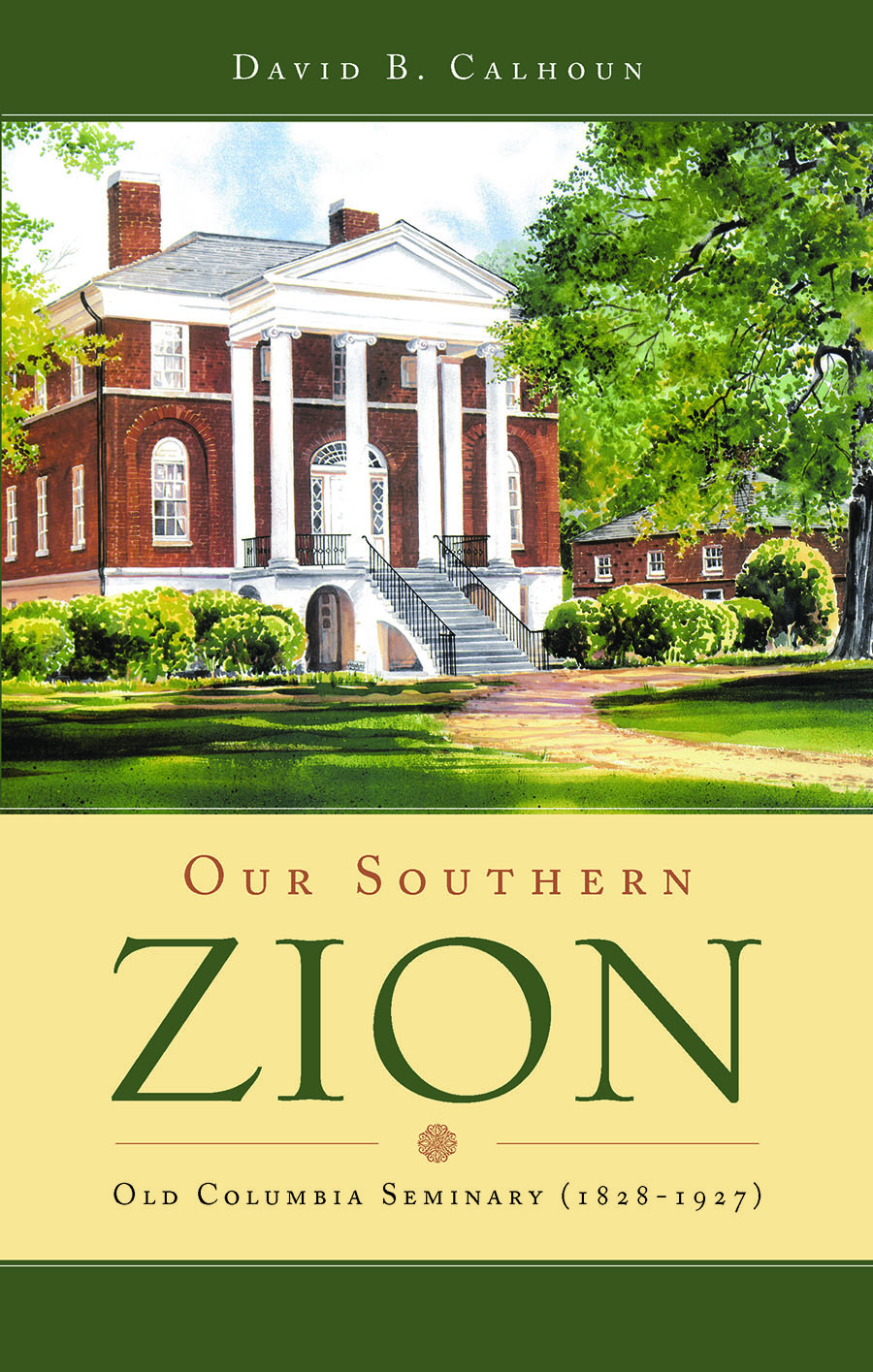Our Southern Zion – A Review by Barry Waugh
The city of Columbia was created the capital of South Carolina by the state legislature in 1786. It was intentionally located near the geographic centre of the state to provide citizens equitable access to their government institutions. The town was laid out two miles square with ten blocks per mile; the streets were built one hundred feet wide except for the two one-hundred-and-fifty feet wide central roads that crossed perpendicularly and divided the city into quadrants. On the lot circumscribed by Pickens, Blanding, Henderson, and Taylor Streets, Ainsley Hall constructed a mansion and out-buildings according to plans drawn by Robert Mills. The house was completed in 1825, but Mr. Hall had died and been buried in the First Presbyterian Church cemetery in 1823. However, the estate left by Ainsley Hall became a blessing for Columbia Theological Seminary when it moved from Lexington, Georgia, and commenced classes with its six students on January 25, 1831. Dr. David B. Calhoun’s Our Southern Zion: Old Columbia Seminary (1828-1927)1 presents the history of the seminary from its founding, through nearly a century in Columbia, until its move to Decatur, Georgia, in 1927.
The clothbound book is attractively covered with a colourful but dignified jacket showing the old Ainsley Hall mansion as rendered in a painting by Erica R. Hoyt. Following the preface by Dr. Douglas F. Kelly of Reformed Seminary, Charlotte, Dr. Calhoun introduces his subject and then, using portions of historical narrative combined with biographical entries, for twenty-eight chapters weaves the story of the seminary. He is especially concerned not only to relate the story of the seminary itself but also its relation to two other Columbia institutions – First Presbyterian Church and South Carolina College (i.e. University of South Carolina). One of Dr. Calhoun’s earlier books The Glory of the Lord Risen Upon It: First Presbyterian Church Columbia, South Carolina, 1795-1995, which was published by the church in 1994, should be considered a sister work due to the close relationship between Columbia Seminary and First Church. With respect to South Carolina College, D. W. Hollis’s University of South Carolina, Volume 1, South Carolina College (1951), provides information regarding the importance of Presbyterians to the college, particularly in the antebellum years. An index is provided at the end of Dr. Calhoun’s book and a section of black-and-white photographs is included to show faces and places associated with the names mentioned in the text.
This year [2012] is the bicentennial of the founding of Princeton Theological Seminary by the Presbyterian Church in the United States of America. Those interested in the remembrance are familiar with the names of Archibald Alexander, Samuel Miller, Charles Hodge, and B. B. Warfield. However, in the case of the early seminaries below the Mason-Dixon Line, Union in Virginia2 and Columbia, represent institutions and faculties that are perhaps unfamiliar to many readers. Columbia faculty members including James H. Thornwell, B. M. Palmer, William S. Plumer, and Francis R. Beattie are more prominent, but other names such as Thomas Goulding (Columbia’s founding professor), Aaron W. Leland, John B. Adger, John L. Girardeau, George Howe, Charles C. Jones, R. C. Reed, Joseph R. Wilson, and H. A. White need more press. David Calhoun’s book provides the information about this lesser-known faculty in a convenient narrative.
The name ‘Woodrow’ has both a positive and a negative association with Columbia Seminary in the years of the nineteenth century following the war and Dr. Calhoun brings out both in the course of his account.
The positive association is Thomas ‘Woodrow’ Wilson who lived in Columbia as a lad while his father, Joseph R. Wilson, taught at the seminary, 1870-1874, and served briefly as the pastor of First Presbyterian Church. Woodrow Wilson, as he was called, would go on to become the twenty-eighth president of the United States. Dr. Calhoun relates that it was in the chapel of the seminary during a devotional meeting when Woodrow Wilson professed his faith in Christ at the age of seventeen and then united with the First Presbyterian Church (p. 214).
The negative association with ‘Woodrow’ concerns controversy at the seminary involving James ‘Woodrow’ who was the brother of Joseph R. Wilson’s wife, Jessie. Calhoun’s chapter ‘The Evolution Controversy’ provides his account of the division at Columbia caused by Woodrow’s views on creation and evolution (pp. 265-80). In 1861, James Woodrow became the Perkins Professor of Natural Science in Connection with Revelation, which had been endowed by Judge John Perkins of Columbus, Mississippi. As the controversy continued to unfold during the years, Robert L. Dabney confronted Woodrow in print, leading to an increase in the debate and more people hearing about Dr. Woodrow’s views. For over twenty years, James Woodrow had been teaching that the Bible did not say how God created man and the universe. His views on creation, along with other positions at variance with the Bible and confessional standards, heightened the controversy. At the request of the Columbia board, faculty, and students, Woodrow delivered a lecture on his views that was published in the Southern Presbyterian Review for July 1884.
Soon thereafter John B. Adger published an article in support of Woodrow. Adger’s support of Woodrow was strengthened when Joseph R. Wilson also jumped to the defence of his brother-in-law. The faculty polarized with John L. Girardeau as a key opponent of Woodrow. To add to the problems, seminary supporters were in an uproar and giving had been affected. The board had supported Woodrow and allowed him to continue teaching, but as the board membership changed the opponents of Woodrow gained the majority and he was permanently removed from the faculty in 1886. He was never convicted of heresy and remained a minister in good standing in the P.C.U.S. He finished his career teaching at South Carolina College and served as its president, 1891-1897. The seminary had suffered through the recent war, struggled through Reconstruction, and survived continued financial problems only to have its own civil war in the Woodrow evolution controversy.
David Calhoun’s book provides readers with the history of Columbia Theological Seminary in its South Carolina years and an introduction to the influence of Presbyterianism within the state. As with his earlier books,3 the clearly written narrative provides information on many subjects and people as he unfolds the history. The old Columbia campus exists today as the Robert Mills House museum. The dormitory buildings abutting the main house have been removed, but the property appears as it would have in the early days of the seminary. The current stable is a replica because the original stable, which served as the seminary chapel, is on the campus of Winthrop University in Rock Hill. With the historical guidance of David Calhoun’s Our Southern Zion, one can not only read about Columbia’s faculty and its years in South Carolina, but also walk the floors that many students and faculty trod over the years.
Sources and additional reading – the information on Columbia was found in John H. Moore’s article ‘Columbia’ published in Walter Edgar, ed., The South Carolina Encyclopedia (Columbia: The University of South Carolina Press, 2006); D. G. Hart and Mark A. Noll, eds., Dictionary of the Presbyterian and Reformed Tradition in America (Downers Grove: InterVarsity Press, 1999); E. C. Scott, Ministerial Directory of the Presbyterian Church, U.S., 1861-1941 (1942); C. N. Willborn, ‘John L. Girardeau (1825-98): Pastor to Slaves and Theologian of Causes,’ Ph.D. dissertation, Westminster Theological Seminary, Philadelphia, 2003;Memorial Volume of the Semi-Centennial of the Theological Seminary at Columbia, South Carolina (Columbia: Presbyterian Publishing House, 1884).
Notes

Our Southern Zion
Old Columbia Seminary (1828-1927)
price £16.00Description
The city of Columbia was created the capital of South Carolina by the state legislature in 1786. It was intentionally located near the geographic centre of the state to provide citizens equitable access to their government institutions. The town was laid out two miles square with ten blocks per mile; the streets were built one […]
- Union Theological Seminary had its beginnings at Hampden-Sydney College in Virginia as a theological programme within the college until the seminary became its own entity on the college campus. The seminary as a Presbyterian governed institution came under the Synod of Virginia in 1812, following a time under the Hanover Presbytery. Union traces its origins to the theological classes taught by Moses Hoge from 1807-1812 at Hampden-Sydney. My impression is that the early records are limited and there is some debate about the starting date of the seminary. See pages 3-5 in W. W. Moore and Tilden Scherer, eds., Centennial General Catalogue of the Trustees, Officers, Professors and Alumni of Union Theological Seminary in Virginia: 1807-1907 (Richmond, 1907). R. L. Dabney was a professor at Union for thirty years until his move to Texas to teach at what is currently the University of Texas and Austin Theological Seminary.
- See David Calhoun’s two-volume history of Princeton Theological Seminary: Volume 1: Princeton Seminary: Faith and Learning 1812-1868 and Volume 2: Princeton Seminary: The Majestic Testimony 1869-1929.
Dr. Barry Waugh (Ph.D., Westminster Theological Seminary) is a historian and writer. He lives in Greenville, South Carolina with his wife. This review is taken with permission from the reformation21 website (Notes 1 & 3 added).
Latest Articles
Finished!: A Message for Easter 28 March 2024
Think about someone being selected and sent to do an especially difficult job. Some major crisis has arisen, or some massive problem needs to be tackled, and it requires the knowledge, the experience, the skill-set, the leadership that they so remarkably possess. It was like that with Jesus. Entrusted to him by God the Father […]
Every Christian a Publisher! 27 February 2024
The following article appeared in Issue 291 of the Banner Magazine, dated December 1987. ‘The Lord gave the word; great was the company of those that published it’ (Psalm 68.11) THE NEED FOR TRUTH I would like to speak to you today about the importance of the use of literature in the church, for evangelism, […]
